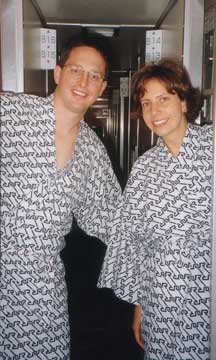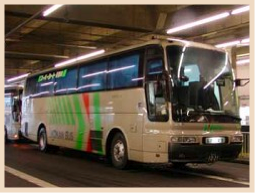
Todd Jay Leonard, Blog


Continuing my series of "Todd's Top Ten List of Things Japanese," I have decided to put "public transportation" in the No. 3 spot.
Public transportation in Japan is out of this world. Essentially, one can travel to just about anywhere in Japan using some form of public transportation that is quick, convenient, practical and always on time. Between trains, planes, buses, ships and bicycles, people travel to and fro all over Japan, every day.
I never owned a car in Japan, and frankly, I do not really need one. I can get everywhere I need to go by public transportation or bicycle. Even though I only spend a month or two in the United States each year, I do own and maintain a car in Indiana. It is not for luxury but out of necessity. I need a vehicle to get to the places I need to go.
I did try renting a car on a few trips home, but the cost was so prohibitively expensive that after a few years, it became more economical to purchase an older car to have and use when I am stateside. My need is purely functional, so I have a '98 Buick Le Sabre that I drive around Shelbyville. I use it so little that I figure it will become a classic before I even begin to wear it out.
A little too far for lunch
Since I live at the northernmost tip of the main island of Honshu, getting to and from here can be problematic. When friends happen to be coming to Tokyo on business, they will often e-mail me their itinerary, suggesting we meet for lunch or dinner while they are in town. That would be nice, except it costs me around $450 round-trip to fly to Tokyo. An overnight bus can get me there and back for about half that, but it takes nine hours each way.
The bullet train is more expensive than the night bus but still takes a minimum of six hours and costs about $250. So, unless I am going to be there for another reason that happens to coincide with a friend's visit to Japan, rarely do I make the effort to meet someone for a quick lunch in Tokyo. It would be similar to a Japanese visitor traveling to New York asking a Hoosier to meet up for drinks in Manhattan.
Of course, I always extend an invitation for people to visit me, but once they realize how much time and effort it takes (not to mention the cost) to travel to Aomori, we usually just have a nice, long chat by phone.
That is the primary drawback of the public transportation system in Japan - the cost. For people living here, it becomes a part of daily life, so the cost is not the overriding concern when deciding whether or not to take a trip by plane, bullet train or overnight bus. It's Japan - of course, it's expensive!
There's always a way
With that said, however, Japanese really do know how to make transportation efficient, comfortable and easy. For instance, when I am needed in Tokyo for business, I will usually fly, because the cost is covered by the organization inviting me. For a nominal fee (around $15) I have door-to-door taxi service that picks me up at my home and delivers me to the airport, which is about an hour's drive.
It is called a "jumbo taxi," and it picks up passengers at their homes who reserve a spot ahead of time. This makes traveling to the airport hassle-free and easy. Otherwise, I'd have to take a regular taxi to the bus station in order to take a public bus to the airport.
From the nearest domestic airport in my prefecture, I take the hour flight to Tokyo. Once in Tokyo, I can hop on the monorail from the airport to central Tokyo, where I can take one of many train lines to get to anywhere within Tokyo quickly and effortlessly.
In the winter, I rarely chance taking a plane to Tokyo because of the risk that snow will either delay or cancel the flight. Instead, I opt to travel by bullet train (Shinkansen), which is quite sleek and comfortable.
I especially enjoy the scenery while traveling from the extreme north down to Tokyo in the south. It is quite interesting to observe the contrasts, not only in terrain changes but also in the landscape and surroundings, going from a very rural area to ultra-cosmopolitan Tokyo.
Since the Shinkansen doesn't have service to my city, I must take an express train to Hachinohe on the eastern side of the prefecture (about two hours away) to catch the bullet train to Tokyo. This means I only have one train change to get all the way to Tokyo, making it quite doable but a bit longer than if I traveled by plane.
The fabled "bullet train" of Japan is actually made up of a number of separate lines that provide transportation all over the main island, even crossing over to Kyushu Island, terminating in Fukuoka. It glides very smoothly at incredible speeds, passing through cities, towns, villages and farmland as it makes its way to all the major cities.
A sleeper-train is another possibility, allowing passengers to depart in the evening and arrive early the next morning to their destination.
There are a number of options, from couchettes to private rooms to regular seats on these types of trains. Couchettes are basically a type of bunk bed that allows four people in one compartment. A curtain can be drawn around the bed for privacy. A private cubicle is what I prefer, and isn't that much more expensive than the couchette. It isn't for people who feel claustrophobic, however, because it is very narrow and only allows you to sit up. A small light and radio is included, as well as a small window to look out. These tiny cubicles remind me of the pods in "capsule hotels" for which Japan is quite well-known.
Private rooms can be reserved as singles or doubles and are priced depending upon the class of service. There are basically two classes: A and B. The "B" class is less expensive and isn't as nice. "A" class is nicer, but pricier. In addition, there is a "Special A Class" that is quite luxurious, costing around $650 per person, round-trip.
It certainly wouldn't be as nice as the Oriental Express, so for the price, it seems a bit exorbitant to spend that kind of money for an overnight train ride.
These overnight trains often furnish passengers with a lightweight yukata (summer kimono) and slippers. For heavy sleepers who don't mind the gentle swaying of a moving train, this mode of transportation is best because, with the entire night spent on the train, it saves one the cost of hotel lodging.
Leave the driving to us
Going to Tokyo by bus can be the least expensive, offering a variety of options. Many of my students take a day bus that is quite cheap, but it takes nearly all day to get there. One alternative that I resort to on occasion is the night bus. Leaving at 10 p.m. from my city, it arrives at around 7 the next morning in Tokyo.
There is an extra-posh "super seat" that I often reserve. It reclines flat and has a cubbyhole for your legs, allowing you to lie down completely. It has a curtain that is pulled completely around the seat, allowing for complete privacy. With a sleep aid, one can get some quality shuteye, but it is a bus and it does rock back and forth.
A toilet is located in the back, but maneuvering through the darkened bus full of sleeping people and using the facilities while it is moving, can be daunting. The restroom is so small that it makes the economy facilities on planes seem big.
A hot towel is given to each passenger in the morning to freshen up before disembarking and fighting the infamous Tokyo morning rush hour on the subway and train lines.
Ships or ferries are another way to get from the northern part of Japan down to Tokyo or even further south. These take much longer, but can be fun if time is not an issue.
At the beginning of the article, I included bicycles. This is not the most practical way to get around Japan if one has to travel a long distance, but many cities do offer bicycles for tourists to either use for free or to rent inexpensively to tour the city leisurely. Hirosaki has this system, and the bicycles can be checked out at the train station and dropped off at a variety of sites around the city.
All in all, I am quite impressed with Japan's innovation and creativity when it comes to public transportation. I can even take a clickety-clackety local train from downtown Hirosaki to my school, which takes five minutes (walking takes about 40). I also have a choice of a bus, taxi, my bicycle and, of course, my legs to get me from one place to another. I am actually glad I don't have a car here, because as it stands, I have a mere 10-minute walk from my home to my university. I know if I had a car, I would fall into the American habit of driving this short distance. It does force me to stay fit ... whether I like it or not.

By TODD JAY LEONARD
Columnist
Trains, buses and bicycles
Monday, May 9 , 2007








